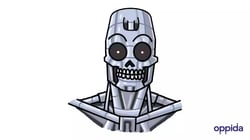Welcome to the world of e-learning design, a space where effective learning design strategies and...
Is Artificial Intelligence the future of learning design?

Much has been made of the impact of Artificial Intelligence (AI) on the future of learning design, education and the implications for students and teachers in the future. I remember back to 2016 reading a report on how a virtual teaching assistant, created with the IBM Watson software, had been deployed at Georgia Tech by a computer science professor to assist with online course queries. At the time, my career had been predominantly in student support and counselling, and I found the results, which showed that most students were blissfully unaware they were interacting with a sophisticated chatbot, were both surprising and somewhat expected. After all, I am an 80’s kid (think Weird Science) and a Stanley Kubrick fan.
Now, a few years deep into a career pivot into learning design, and I find myself still regularly amazed at times (wait, that wasn’t Obama?!), but also somewhat complacent when it comes to AI in online education. Rather than producing another piece on the pros and cons of AI in education and whether one day Skynet will rise up and replace all teachers, I thought I would narrow this piece down to the implications for the learning design community and how as a learning designer, I am already experiencing the benefits and challenges of Artificial Intelligence in my profession.
Artificial Intelligence in learning design: Level 1

A learning designer is required to perform a multitude of tasks and many of those revolve around content. I hadn’t paid much attention to it before, but even something as simple as having Smart Compose turned on in Google Docs when storyboarding and writing content is a form of Artificial Intelligence. That is probably the least complex example I can think of and it certainly doesn’t make my job significantly easier, but moving up the complexity chain and I certainly experience a lot more benefits when it comes to audio transcription. Gone are the days of meticulously transcribing video content, and whilst most AI transcription services only offer around 90% accuracy (who wants to start a blog with me called ‘When Artificial Intelligence transcription goes wrong’), it certainly cuts down on the time needed to perform such tasks.
Artificial Intelligence in learning design: Level 2

A learning designer is often required to become an instant expert. For me, the biggest perk of the job is that I get to contribute to courses from a wide range of subject areas, and in doing so, I am constantly learning myself.
| Side note: fellow LD’s, when are we going to unionise and demand that we get a transcript for completing a unit every time we design one? If we practically write the thing, surely it should go on our academic record? |
But in instances where we may not have access to an SME, it can be challenging to design assessment tasks. That’s where something like Quillionz comes in handy. Promoted as the world’s first AI-powered platform for creating questions, quizzes and notes, you can upload a slab of text and have some questions automatically generated for you. Will I ever admit to using this? No. Of course not.
Artificial Intelligence in learning design: Level 3

One of the more arduous tasks in learning design is the constant search for open-source photos. Whilst I personally tend to avoid those SCORMy storyline style animated characters that we have all experienced in corporate online training, there are occasions where ideally, we would like to use real human beings, in multiple poses and with varying facial expressions. I of course advocate for sticking to copyright and for financially compensating models, but that might be a thing of the past with new services such as Generated Photos. None of the humans on that site are real, and you can make the same face young or old, angry or happy, looking left or right, however you want! With deepfake technology becoming more accessible I personally cannot wait to be able to morph that instructor in the Accounting 101 video into a doppelganger of Kanye West!
Artificial intelligence in learning design: level 19999

So where to from here? There’s no doubt learning design as a profession is booming and is only expected to rise. But like many other occupations, are we at risk of being replaced by AI? Recently I spoke with Dan Sleeman, the creator of Biliti. Promoted as using “sophisticated data analytics and Artificial Intelligence to equip teachers, course designers, talent managers, and online education leaders with the intelligence and insight to best align learning to workplace demand”, Dan believes Biliti can support educators to move further up the value chain, and focus their time and energy on necessary complex and creative tasks, and less on administrative and analytical tasks, and processes. With AI technology increasingly being able to do the heavy lifting, educators and learning designers can continue to craft meaningful learning experiences in even more efficient ways.
Perhaps then, it is efficiency that is most likely to receive the biggest boost from AI in the life of a learning designer. As we have seen in the examples highlighted, typical LD tasks such as content writing, the sourcing of graphic design elements, accessibility procedures and the creation of formative assessments can all become much faster. I can even envisage rich content editors becoming sentient and learning to talk (and cooperate) across platforms. But in lieu of an algorithm that can fully automate the development process (I shall call her… ADDIE!), I feel learning designers are safe from the robocalypse for now. Instead, LDs can focus on leveraging the tools and possibilities AI provides us with to push our profession forward and to continue to shine a light on the importance of quality learning design. In fact, it might be us that rise up and start taking over some traditional academic roles…



